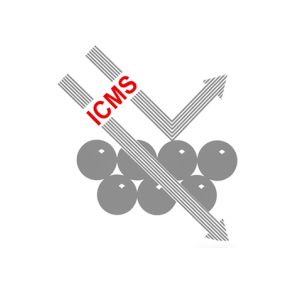Scientific Papers in SCI
2015
2015
Química de Superficies y Catálisis
Ni-CeO2/C Catalysts with Enhanced OSC for the WGS Reaction
Pastor-Perez, L; Ramirez Reina, T; Ivanova, S; Centeno, MA; Odriozola, JA; Sepulveda-Escribano, ACatalysts, 5 (2015) 298-309 DOI: 10.3390/catal5010298
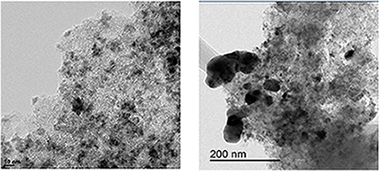
Abstract
In this work, the WGS performance of a conventional Ni/CeO2 bulk catalyst is compared to that of a carbon-supported Ni-CeO2 catalyst. The carbon-supported sample resulted to be much more active than the bulk one. The higher activity of the Ni-CeO2/C catalyst is associated to its oxygen storage capacity, a parameter that strongly influences the WGS behavior. The stability of the carbon-supported catalyst under realistic operation conditions is also a subject of this paper. In summary, our study represents an approach towards a new generation of Ni-ceria based catalyst for the pure hydrogen production via WGS. The dispersion of ceria nanoparticles on an activated carbon support drives to improved catalytic skills with a considerable reduction of the amount of ceria in the catalyst formulation.
March, 2015 · DOI: 10.3390/catal5010298
Química de Superficies y Catálisis
Ionic liquid immobilization on carbon nanofibers and zeolites: Catalyst design for the liquid-phase toluene chlorination
Losch, Pit; Martinez Pascual, Antonio; Boltz, Marilyne; Ivanova, Svetlana; Louis, Benoit; Montilla, Francisco; Antonio Odriozola, JoseComptes Rendus Chimie, 18 (2015) 324-329 DOI: 10.1016/j.crci.2014.06.006

Abstract
The environmental-friendly chlorination reaction of toluene by trichloroisocyanuric acid (TCCA, C3N3O3Cl3) was investigated applying immobilized ionic liquids (ILs) on different supports. Ionic liquids were grafted either on carbon nanofibers (CNF) or encapsulated in zeolites. Their influence on the chlorination activity as well as on the selectivity in different chlorinated products was studied. An unusually high selectivity toward meta-chlorotoluene was achieved, up to 36%. Hence, the selectivity could be tuned to produce either expected ortho-/para-chlorotoluene or meta-chlorotoluene with a proper support choice.
March, 2015 · DOI: 10.1016/j.crci.2014.06.006
Nanotecnología en Superficies y Plasma
Nanocolumnar coatings with selective behavior towards osteoblast and Staphylococcus aureus proliferation
Izquierdo-Barba, Isabel; Miguel Garcia-Martin, Jose; Alvarez, Rafael; Palmero, Alberto; Esteban, Jaime; Perez-Jorge, Concepcion; Arcos, Daniel; Vallet-Regi, MariaActa Biomaterialia, 15 (2015) 20-28 DOI: 10.1016/j.actbio.2014.12.023
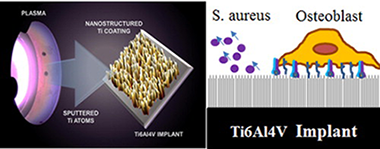
Abstract
Bacterial colonization and biofilm formation on orthopedic implants is one of the worst scenarios in orthopedic surgery, in terms of both patient prognosis and healthcare costs. Tailoring the surfaces of implants at the nanoscale to actively promote bone bonding while avoiding bacterial colonization represents an interesting challenge to achieving better clinical outcomes. Herein, a Ti6Al4V alloy of medical grade has been coated with Ti nanostructures employing the glancing angle deposition technique by magnetron sputtering. The resulting surfaces have a high density of nanocolumnar structures, which exhibit strongly impaired bacterial adhesion that inhibits biofilm formation, while osteoblasts exhibit good cell response with similar behavior to the initial substrates. These results are discussed on the basis of a "lotus leaf effect" induced by the surface nanostructures and the different sizes and biological characteristics of osteoblasts and Staphylococcus aureus.
March, 2015 · DOI: 10.1016/j.actbio.2014.12.023
Materiales de Diseño para la Energía y Medioambiente
Microstructure, elastic and inelastic properties of partially graphitized biomorphic carbons
Orlova, TS; Kardashev, BK; Smirnov, BI; Gutierrez-Pardo, A; Ramirez-Rico, J; Martinez-Fernandez, JPhysics of the Solid State, 57 (2015) 586-591 DOI: 10.1134/S106378341503018X

Abstract
The microstructural characteristics and amplitude dependences of the Young's modulus E and internal friction (logarithmic decrement delta) of biocarbon matrices prepared by beech wood carbonization at temperatures T (carb) = 850-1600A degrees C in the presence of a nickel-containing catalyst have been studied. Using X-ray diffraction and electron microscopy, it has been shown that the use of a nickel catalyst during carbonization results in a partial graphitization of biocarbons at T (carb) a parts per thousand yen 1000A degrees C: the graphite phase is formed as 50- to 100-nm globules at T (carb) = 1000A degrees C and as 0.5- to 3.0-mu m globules at T (carb) = 1600A degrees C. It has been found that the measured dependences E(T (carb)) and delta(T (carb)) contain three characteristic ranges of variations in the Young's modulus and logarithmic decrement with a change in the carbonization temperature: E increases and delta decreases in the ranges T (carb) < 1000A degrees C and T (carb) > 1300A degrees C; in the range 1000 < T (carb) < 1300A degrees C, E sharply decreases and delta increases. The observed behavior of E(T (carb)) and delta(T (carb)) for biocarbons carbonized in the presence of nickel correlates with the evolution of their microstructure. The largest values of E are obtained for samples with T (carb) = 1000 and 1600A degrees C. However, the samples with T (carb) = 1600A degrees C exhibit a higher susceptibility to microplasticity due to the presence of a globular graphite phase that is significantly larger in size and total volume.
March, 2015 · DOI: 10.1134/S106378341503018X
Materiales de Diseño para la Energía y Medioambiente
Effect of catalytic graphitization on the electrochemical behavior of wood derived carbons for use in supercapacitors
Gutierrez-Pardo, A; Ramirez-Rico, J; Cabezas-Rodriguez, R; Martinez-Fernandez, JJournal of Power Sources, 278 (2015) 18-26 DOI: 10.1016/j.jpowsour.2014.12.030
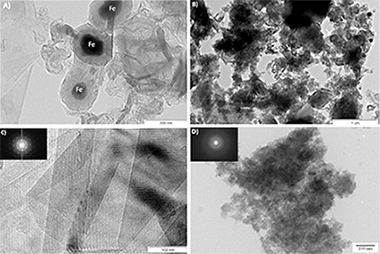
Abstract
Porous graphitic carbons were successfully obtained from wood precursors through pyrolysis using a transition metal as catalyst. Once the catalyst is removed, the resulting material mimics the microstructure of the wood and presents high surface area, open and interconnected porosity and large pore volume, high crystallinity and good electrical conductivity, making these carbons interesting for electrochemical devices. Carbons obtained were studied as electrodes for supercapacitors in half cell experiments, obtaining high capacitance values in a basic media (up to 133 F g−1 at current densities of 20 mA g−1 and 35 F g−1 at current densities of 1 A g−1). Long-cycling experiments showed excellent stability of the electrodes with no reduction of the initial capacitance values after 1000 cycles in voltammetry.
March, 2015 · DOI: 10.1016/j.jpowsour.2014.12.030
Materiales Avanzados
Valorization and inertization of galvanic sludge waste in clay bricks
Perez-Villarejo, L; Martinez-Martinez, S; Carrasco-Hurtado, B; Eliche-Quesada, D; Urena-Nieto, C; Sanchez-Soto, PJApplied Clay Science, 105-106 (2015) 89-99 DOI: 10.1016/j.clay.2014.12.022

Abstract
Galvanic sludge wastes (GSW) are produced by the physico-chemical treatments of wastewater generated by electroplating plants. These materials have a significant potential for the production of clay ceramic bricks. This paper focuses on the viability of the inertization of heavy metals from GSW mixed with clays. The original materials were obtained by mixing three types of raw clay (red, yellow and black) in equal parts with GSW. These mixtures were characterized by XRD, XRF, and chemical elemental analysis CHNS. The dosage of GSW in the clay–GSW bricks was up to 5 wt.%. The bricks were then manufactured using conventional processes. The influence of the amount of GSW was evaluated after firing the clay–GSW composites at 950 °C for 1 h. The engineering properties of the fired samples, such as density, water absorption, open porosity, water suction and compressive strength, with and without the GSW, were determined. The incorporation of GSW into the clay mix clearly decreased the linear shrinkage and bulk density of the bricks in comparison with the fired clay used as a control. These GSW–clay composites also showed lower open porosity. According to the results obtained for the bulk density of the bricks, samples with GSW addition showed slightly lower values of open porosity than clay bodies, indicating that the GSW–clay samples had slightly higher closed porosity values. This was also shown by SEM. The open porosity, SEM and pore size distribution tests indicated that the porosity generated by the addition of GSW was mainly closed and, therefore, GSW bricks had excellent mechanical properties. The environmental risks of the incorporation of GSW, rich in heavy metals (Cr, Zn, Ni and others), to a clay matrix were evaluated by leaching tests of the fired products. The results indicated a successful inertization of the pollutants.
March, 2015 · DOI: 10.1016/j.clay.2014.12.022
Materiales Ópticos Multifuncionales
Highly Efficient Perovskite Solar Cells with Tunable Structural Color
W. Zhang, M. Anaya, G. Lozano, M.E. Calvo, M.B. Johnston, H. Míguez, H.J. SnaithNano Letters, 15 (2015) 1698-1702 DOI: 10.1021/nl504349z
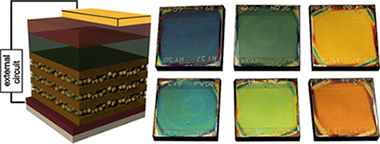
Abstract
The performance of perovskite solar cells has been progressing over the past few years and efficiency is likely to continue to increase. However, a negative aspect for the integration of perovskite solar cells in the built environment is that the color gamut available in these materials is very limited and does not cover the green-to-blue region of the visible spectrum, which has been a big selling point for organic photovoltaics. Here, we integrate a porous photonic crystal (PC) scaffold within the photoactive layer of an opaque perovskite solar cell following a bottom-up approach employing inexpensive and scalable liquid processing techniques. The photovoltaic devices presented herein show high efficiency with tunable color across the visible spectrum. This now imbues the perovskite solar cells with highly desirable properties for cladding in the built environment and encourages design of sustainable colorful buildings and iridescent electric vehicles as future power generation sources.
March, 2015 · DOI: 10.1021/nl504349z
Reactividad de Sólidos
Nanoindentation of (Ti,Ta)(C,N)-Co cermets prepared by methods of mechanochemistry
Hvizdos, Pavol; Balko, Jan; Manuel Cordoba, Jose; Chicardi, ErnestoInternational Journal of Refractory Metals & Hard Materials, 49 (2015) 219-224 DOI: 10.1016/j.ijrmhm.2014.07.038
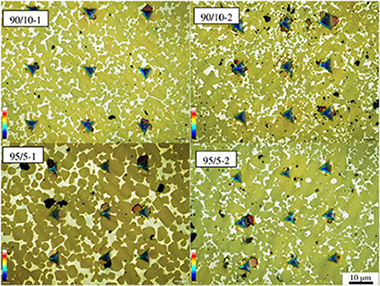
Abstract
Four materials TixTa(1 - x)C(0.5)N(0.5)-20%Co of two chemical compositions (x = 0.9 and 0.95) and two high energy milling methods (one stage and two stage milling) have been prepared. Nano-hardness and elastic modulus for microstructure as a whole and for individual constituent phases (matrix and carbide grains) were obtained by instrumented indentation. Individual targeted indentations as well as grid nanoindentation technique were used to discern the individual constituents' properties. Maximum loads of 20 mN for individual phases and 300 mN for composite microstructure were applied. Materials with higher amount of Ti had larger grains but the milling procedure had stronger influence on the grain size. The two step milling resulted in finer microstructures but with a much wider grain size distribution. Final composite mechanical properties, however, were very similar. Hardness and indentation elasticity modulus of all materials were comparable within the errors of measurement.
March, 2015 · DOI: 10.1016/j.ijrmhm.2014.07.038
Materiales Ópticos Multifuncionales
Sunlight Absorption Engineering for Thermophotovoltaics: Contributions from the Optical Design
Miguez, HChemSusChem, 8 (2015) 786-788 DOI: 10.1002/cssc.201403361

Abstract
Nowadays, solar thermophotovoltaic systems constitute a platform in which sophisticated optical material designs are put into practice with the aim of achieving the long sought after dream of developing an efficient energy conversion device based on this concept. Recent advances demonstrate that higher efficiencies are at reach using photonic nanostructures amenable to mass production and scale-up.
March, 2015 · DOI: 10.1002/cssc.201403361
Materiales de Diseño para la Energía y Medioambiente
Sliding wear resistance of sintered SiC-fiber bonded ceramics
Vera, MC; Ramirez-Rico, J; Martinez-Fernandez, J; Singh, MInternational Journal of Refractory Metals & Hard Materials, 49 (2015) 232-239 DOI: 10.1016/j.ijrmhm.2014.06.020
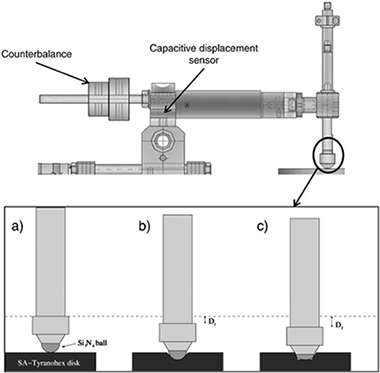
Abstract
Advanced SiC-based ceramics and fiber reinforced composites are interesting materials for a wide variety of applications involving sliding wear conditions because of their excellent thermomechanical properties. The microstructure and wear resistance of sintered SiC fiber bonded ceramics (SA Tyrannohex) were studied. The material is composed of SiC-fibers in two orientations, with polygonal cross sections and cores having higher carbon content than their surroundings, as observed with SEM. A thin layer of C exists between the fibers. This layer has been found to be a turbostratic-layered structure oriented parallel to the fiber surface. XRD shows that the material is highly crystalline and composed mostly of β-SiC. Unlubricated wear behavior of the SA-Tyrannohex material when sliding against a Si3N4 ball in air at room temperature was evaluated. Experiments were performed using a pin on disk apparatus, under different normal loads of 2, 5 and 10 N at sliding speeds of 25, 50, 100 mm/s. A decrease of the friction coefficient with load was found due to the presence of the turbostratic carbon layer between the fibers. Wear rates of the order of 100 mm3/MJ were obtained, independently of sliding speed. Microfracture of the fibers is the main wear mechanism.
March, 2015 · DOI: 10.1016/j.ijrmhm.2014.06.020
Materiales de Diseño para la Energía y Medioambiente
Sliding wear resistance of biomorphic SiC ceramics
Vera, MC; Ramirez-Rico, J; Martinez-Fernandez, J; Singh, MInternational Journal of Refractory Metals & Hard Materials, 49 (2015) 327-333 DOI: 10.1016/j.ijrmhm.2014.07.004
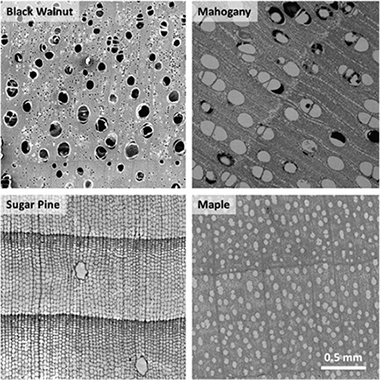
Abstract
Biomorphic SiC ceramics were fabricated from four different wood precursors and their Knoop hardness and sliding wear resistance when sliding against a Si3N4 ball in air were studied. Tribological experiments were performed using a pin on disk apparatus, under normal loads of 2 and 5 N, at a sliding speed of 100 mm/s. The effects of specimen porosity and microstructure on measured wear were evaluated. A commercial sintered silicon carbide ceramic was also tested for comparison. Small differences in friction coefficient comparable to monolithic SiC ceramics were obtained. Several concurrent wear mechanisms are taking place: microfracture, plastic deformation in the Si phase and oxidation of the Si and/or SiC phase. The presence of an oxide tribolayer was assessed using fluorescence microscopy. Wear rates were found to scale with SiC content and depend on residual porosity in the composite.
March, 2015 · DOI: 10.1016/j.ijrmhm.2014.07.004
Química de Superficies y Catálisis
Role of ruthenium on the catalytic properties of CeZr and CeZrCo mixed oxides for glycerol steam reforming reaction toward H2 production
Martinez, LM; Araque, M; Centeno, MA; Roger, ACCatalysis Today, 242 (2015) 80-90 DOI: 10.1016/j.cattod.2014.07.034

Abstract
The effect of ruthenium on the physico-chemical properties of CeZr and CeZrCo mixed oxides for H2production by glycerol steam reforming reaction has been studied. The combination of in situ Raman spectroscopy under both reductive and oxidative conditions, H2/O2 pulses and XRD, Raman, BET analysis, H2-TPR and TPD-TPO analyses contributed to the determination of the structural and textural properties, redox behavior, re-oxidation capacity and resistance to carbon deposition of the synthesized catalysts. The results show that the catalytic activity is improved by the (positive) cooperative and complementary effect between cobalt and ruthenium that favors the selectivity toward the steam reforming, selective to H2, with respect to the unselective thermal decomposition of glycerol. Ruthenium stabilizes the cobalt cations inserted in the fluorite structure preventing its rejection as Co3O4; and provides the necessary hydrogen to reduce Ce4+. The combination cobalt–ruthenium modifies positively the redoxproperties of the catalysts, increases the re-oxidation capacity (OSC) and promotes the gasification of the carbon deposits. Under the reaction conditions, the decrease in glycerol conversion came along with a change of selectivity. The formation of H2 and CO2 were strongly decreased, while the formation of CO, C2H4 and condensable products (mainly hydroxyacetone) increase. The differences in the catalytic stability and activity of the catalysts are related to the capability of the catalysts to activate H2O under the reaction conditions, favoring the steam reforming reaction over the thermal decomposition.
March, 2015 · DOI: 10.1016/j.cattod.2014.07.034
Materiales de Diseño para la Energía y Medioambiente
Polyester Films Obtained by Noncatalyzed Melt-Condensation Polymerization of Aleuritic (9,10,16-Trihydroxyhexadecanoic) Acid in Air
Benitez, JJ; Heredia-Guerrero, JA; Guzman-Puyol, S; Dominguez, E; Heredia, AJournal of Applied Polymer, 132 (2015) Art. 41328 DOI: 10.1002/app.41328
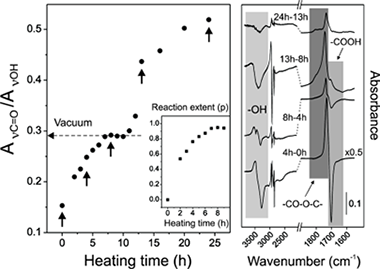
Abstract
To mimic nontoxic and fully biodegradable biopolymers like the plant cutin, polyester films from a natural occurring fatty polyhydroxyacid like aleuritic (9,10,16-trihydroxyhexadecanoic) acid have been prepared by noncatalyzed melt-polycondensation at moderate temperature (150 degrees C) directly in air. The course of the reaction has been followed by infrared spectroscopy, C-13 magic angle spinning nuclear magnetic resonance spectroscopy, differential scanning calorimetry and X-ray diffraction and well differentiated stages are observed. First, a high conversion esterification reaction leads to an amorphous rubbery, infusible, and insoluble material whose structure is made out of ester linkages mostly involving primary hydroxyls and partially branched by minor esterification with secondary ones. Following the esterification stage, the cleavage of vicinal secondary hydroxyls and further oxidation to carboxylic acid is observed at the near surface region of films. New carboxylic groups created also undergo esterification and generate cross-linking points within the polymer structure. Additionally, and despite the harsh preparation conditions used, very little additional side reaction like peroxidation and dehydration are observed. Results demonstrate the feasibility of polyester films fabrication from a reference fatty polyhydroxyacid like aleuritic acid by noncatalyzed melt-polycondensation directly in air. The methodology can potentially be extended to similar natural occurring hydroxyacids to obtain films and coatings to be used, for instance, as nontoxic and biodegradable food packaging material.
February, 2015 · DOI: 10.1002/app.41328
Materiales Nanoestructurados y Microestructura
Tribocorrosion behavior of TiBxCy/a-C nanocomposite coating in strong oxidant disinfectant solutions
Gracia-Escosa, E; Garcia, I; Sanchez-Lopez, JC; Abad, MD; Mariscal, A; Arenas, MA; de Damborenea, J; Conde, ASurface & Coatings Technology, 263 (2015) 78-85 DOI: 10.1016/j.surfcoat.2014.12.047
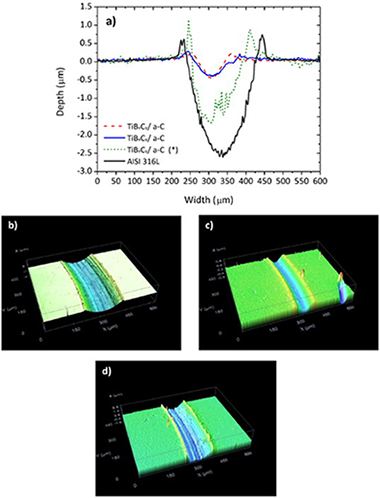
Abstract
Corrosion and tribocorrosion studies of a TiBxCy/a-C coating deposited on AISI 316L steel have been performed in an aqueous solution of 026 vol.% acetic, 0.16 vol.% peracetic and 0.18 vol.% hydrogen peroxide (commercial product Oxonia I vol.%). The corrosion current density of the TiBxCy/a-C coating ranges on the same order as bare steel but with a significantly decreasing friction (0.1 vs. 0.6) and wear rate (similar to 10 times lower). The compact microstructure of the coating hinders the access of the aggressive electrolyte to the substrate, preventing the onset of the corrosion attack, while maintaining an excellent tribological behavior in strong oxidant solutions.
February, 2015 · DOI: 10.1016/j.surfcoat.2014.12.047
Materiales y Procesos Catalíticos de Interés Ambiental y Energético
Evolution of H-2 photoproduction with Cu content on CuOx-TiO2 composite catalysts prepared by a microemulsion method
Kubacka, A; Munoz-Batista, MJ; Fernandez-Garcia, M; Obregon, S; Colon, GApplied Catalysis B: Environmental, 163 (2015) 214-222 DOI: 10.1016/j.apcatb.2014.08.005
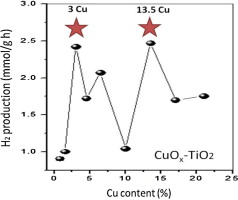
Abstract
Copper oxides in contact with anatase correspond to promising materials with high activity in the photo-production of hydrogen by aqueous reforming of alcohols. By a single pot microemulsion method we obtained a series of Cu-Ti composite systems with controlled copper content in the 0-25 wt.% range. The scanning of such a wide range of composition led to the discovery of two well differentiated maxima in the photo-reaction performance. These maxima present rather high and relatively similar reaction rates and photonic efficiencies but are ascribed to the presence of different copper species. A multi-technique analysis of the materials indicates that the maxima obtained comes from optimizing different steps of the reaction; while the first would be connected with a positive effect on anatase charge handling performance the second seems exclusively related to electron capture by surface copper species.
February, 2015 · DOI: 10.1016/j.apcatb.2014.08.005
Materiales y Procesos Catalíticos de Interés Ambiental y Energético
Effective photoreduction of a nitroaromatic environmental endocrine disruptor by AgNPs functionalized on nanocrystalline TiO2
Hernandez-Gordillo, A; Obregon, S; Paraguay-Delgado, F; Rodriguez-Gonzalez, VRSC Advances, 5 (2015) 15194-15197 DOI: 10.1039/c5ra00094g

Abstract
Unprecedented photoactivity of silver nanoparticles photodeposited on nanocrystalline TiO2 for the efficient reduction of 4-nitrophenol at room temperature is reported. The use of Na2SO3 as a harmless scavenger agent for the reduction of a nitroaromatic endocrine disruptor yields a valuable 4-aminophenol reagent.
February, 2015 · DOI: 10.1039/c5ra00094g
Materiales Ópticos Multifuncionales - Nanotecnología en Superficies y Plasma
Flexible Distributed Bragg Reflectors from Nanocolumnar Templates
Calvo, ME; Gonzalez-Garcia, L; Parra-Barranco, J; Barranco, A; Jimenez-Solano, A; Gonzalez-Elipe, AR; Miguez, HAdvanced Optical Materials, 3 (2015) 171-175 DOI: 10.1002/adom.201400338

Abstract
A flexible distributed Bragg reflector is made by the infiltration of a nanocolumnar array with polydimethyl siloxane oligomers. The high optical reflectance displayed by the final material is a direct consequence of the high refractive index contrast of the columnar layers whereas the structural stability is due to the polymer properties.
February, 2015 · DOI: 10.1002/adom.201400338
Materiales y Procesos Catalíticos de Interés Ambiental y Energético
Photocatalytic activity of bismuth vanadates under UV-A and visible light irradiation: Inactivation of Escherichia coli vs oxidation of methanol
Adan, C; Marugan, J; Obregon, S; Colon, GCatalysis Today, 240 (2015) 93-99 DOI: 10.1016/j.cattod.2014.03.059
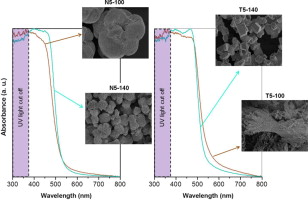
Abstract
Four bismuth vanadates have been synthesized by using two different precipitating agents (NH3 and triethylamine) following a hydrothermal treatment at 100 °C for 2 h and at 140 °C for 20 h. Then, solids were characterized by X-ray diffraction, BET surface area, UV–vis spectroscopy and scanning microscopy techniques. The characterization of the synthesized materials showed a well crystallized scheelite monoclinic structure with different morphologies. All materials display optimum light absorption properties for visible light photocatalytic applications. The photocatalytic activity of the catalysts was investigated for the inactivation of Escherichia coli bacteria and the oxidation of methanol under UV–vis and visible light irradiation sources. Main results demonstrate that BiVO4 are photocatalytically active in the oxidation of methanol and are able to inactivate bacteria below the detection level. The activity of the catalyst decreases when using visible light, especially for methanol oxidation, pointing out differences in the reaction mechanism. In contrast with bacteria, whose interaction with the catalyst is limited to the external surface, methanol molecules can access the whole material surface.
February, 2015 · DOI: 10.1016/j.cattod.2014.03.059
Nanotecnología en Superficies y Plasma
Laser Treatment of Ag@ZnO Nanorods as Long-Life-Span SERS Surfaces
Macias-Montero, M; Pelaez, RJ; Rico, VJ; Saghi, Z; Midgley, P; Afonso, CN; Gonzalez-Elipe, AR; Borras, AACS Applied Materials & Interfaces, 7 (2015) 2331-2339 DOI: 10.1021/am506622x
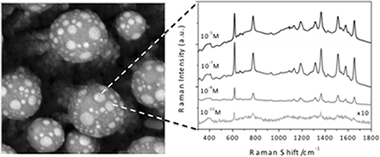
Abstract
UV nanosecond laser pulses have been used to produce a unique surface nanostructuration of Ag@ZnO supported nanorods (NRs). The NRs were fabricated by plasma enhanced chemical vapor deposition (PECVD) at low temperature applying a silver layer as promoter. The irradiation of these structures with single nanosecond pulses of an ArF laser produces the melting and reshaping of the end of the NRs that aggregate in the form of bundles terminated by melted ZnO spherical particles. Well-defined silver nanoparticles (NPs), formed by phase separation at the surface of these melted ZnO particles, give rise to a broad plasmonic response consistent with their anisotropic shape. Surface enhanced Raman scattering (SERS) in the as-prepared Ag@ZnO NRs arrays was proved by using a Rhodamine 6G (Rh6G) chromophore as standard analyte. The surface modifications induced by laser treatment improve the stability of this system as SERS substrate while preserving its activity.
February, 2015 · DOI: 10.1021/am506622x
Nanotecnología en Superficies y Plasma
Active vacuum brazing of CNT films to metal substrates for superior electron field emission performance
Longtin, R; Sanchez-Valencia, JR; Shorubalko, I; Furrer, R; Hack, E; Elsener, H; Groning, O; Greenwood, P; Rupesinghe, N; Teo, K; Leinenbach, C; Groning, PScience and Technology of Advanced Materials, 16 (2015) 015005 (11 pp) DOI: 10.1088/1468-6996/16/1/015005
Abstract
The joining of macroscopic films of vertically aligned multiwalled carbon nanotubes (CNTs) to titanium substrates is demonstrated by active vacuum brazing at 820 degrees C with a Ag-Cu-Ti alloy and at 880 degrees C with a Cu-Sn-Ti-Zr alloy. The brazing methodology was elaborated in order to enable the production of highly electrically and thermally conductive CNT/metal substrate contacts. The interfacial electrical resistances of the joints were measured to be as low as 0.35 Omega. The improved interfacial transport properties in the brazed films lead to superior electron fieldemission properties when compared to the as-grown films. An emission current of 150 mu A was drawn from the brazed nanotubes at an applied electric field of 0.6 V mu m(-1). The improvement in electron field-emission is mainly attributed to the reduction of the contact resistance between the nanotubes and the substrate. The joints have high re-melting temperatures up to the solidus temperatures of the alloys; far greater than what is achievable with standard solders, thus expanding the application potential of CNT films to high-current and high-power applications where substantial frictional or resistive heating is expected.
February, 2015 · DOI: 10.1088/1468-6996/16/1/015005
Reactividad de Sólidos
Ca-looping for postcombustion CO2 capture: A comparative analysis on the performances of dolomite and limestone
Valverde, JM; Sanchez-Jimenez, PE; Perez-Maqueda, LAApplied Energy, 138 (2015) 202-215 DOI: 10.1016/j.apenergy.2014.10.087
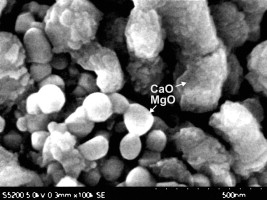
Abstract
The low cost and wide availability of natural limestone (CaCO3) is at the basis of the industrial competitiveness of the Ca-looping (CaL) technology for postcombustion CO2 capture as already demonstrated by similar to 1 Mw(t) scale pilot projects. A major focus of studies oriented towards further improving the efficiency of the CaL technology is how to prevent the gradual loss of capture capacity of limestone derived CaO as the number of carbonation/calcination cycles is increased. Natural dolomite (MgCa(CO3)(2)) has been proposed as an alternative sorbent precursor to limestone. Yet, carbonation of MgO is not thermodynamically favorable at CaL conditions, which may hinder the capture performance of dolomite. In the work described in this paper we carried out a thermogravimetric analysis on the multicyclic capture performance of natural dolomite under realistic regeneration conditions necessarily implying high calcination temperature, high CO2 concentration and fast transitions between the carbonation and calcination stages. Our study demonstrates that the sorbent derived from dolomite has a greater capture capacity as compared to limestone. SEM analysis shows that MgO grains in the decomposed dolomite are resistant to sintering under severe calcination conditions and segregate from CaO acting as a thermally stable support which mitigates the multicyclic loss of CaO conversion. Moreover, full decomposition of dolomite is achieved at significantly lower calcination temperatures as compared to limestone, which would help improving further the industrial competitiveness of the technology.
February, 2015 · DOI: 10.1016/j.apenergy.2014.10.087
Propiedades mecánicas, modelización y caracterización de cerámicos avanzados
Ultra-fast and energy-efficient sintering of ceramics by electric current concentration
Zapata-Solvas, E; Gomez-Garcia, D; Dominguez-Rodriguez, A; Todd, RIScientific Reports, 5 (2015) art n. 8513 DOI: 10.1038/srep08513
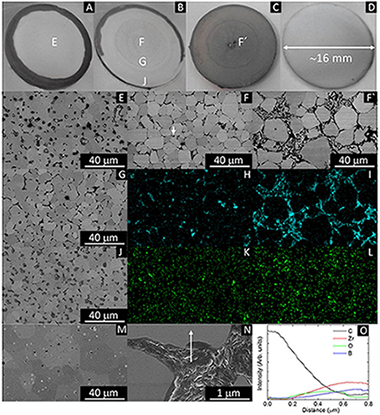
Abstract
Electric current activated/assisted sintering (ECAS) techniques, such as electrical discharge sintering (EDS) or resistive sintering (RS), have been intensively investigated for longer than 50 years. In this work, a novel system including an electrically insulated graphite die for Spark Plasma Sintering (SPS) is described, which allows the sintering of any refractory ceramic material in less than 1 minute starting from room temperature with heating rates higher than 2000°C/min and an energy consumption up to 100 times lower than with SPS. The system alternates or combines direct resistive sintering (DRS) and indirect resistive sintering (IRS). Electrical insulation of the die has been achieved through the insertion of a film made of alumina fibers between the graphite die and the graphite punches, which are protected from the alumina fiber film by a graphite foil. This system localized the electric current directly through the sample (conductive materials) as in DRS and EDS, or through the thin graphite foil (non-conductive materials) as in IRS, and is the first system capable of being used under EDS or RS conditions independently combining current concentration/localization phenomena.
February, 2015 · DOI: 10.1038/srep08513
Materiales y Procesos Catalíticos de Interés Ambiental y Energético
Structural and chemical reactivity modifications of a cobalt perovskite induced by Sr-substitution. An in situ XAS study
Hueso, JL; Holgado, JP; Pereniguez, R; Gonzalez-DelaCruz, VM; Caballero, AMaterials Chemistry and Physics, 151 (2015) 29-33 DOI: 10.1016/j.matchemphys.2014.11.015
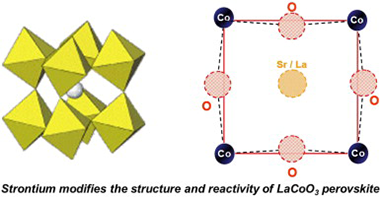
Abstract
LaCoO3 and La0.5Sr0.5O3O3-delta perovskites have been studied by in situ Co K-edge XAS. Although the partial substitution of La(III) by Sr(II) species induces an important increase in the catalytic oxidation activity and modifies the electronic state of the perovskite, no changes could be detected in the oxidation state of cobalt atoms. So, maintaining the electroneutrality of the perovskite requires the generation of oxygen vacancies in the network. The presence of these vacancies explains that the substituted perovskite is now much more reducible than the original LaCoO3 perovskite. As detected by in situ XAS, after a consecutive reduction and oxidation treatment, the original crystalline structure of the LaCoO3 perovskite is maintained, although in a more disordered state, which is not the case for the Sr doped perovskite. So, the La0.5Sr0.5CoO3-delta perovskite submitted to the same hydrogen reduction treatment produces metallic cobalt, while as determined by in situ XAS spectroscopy the subsequent oxidation treatment yields a Co(III) oxide phase with spinel structure. Surprisingly, no Co(II) species are detected in this new spinel phase.
February, 2015 · DOI: 10.1016/j.matchemphys.2014.11.015
Reactividad de Sólidos
Synthesis of a nanosilica supported CO2 sorbent in a fluidized bed reactor
Soria-Hoyo, C; Valverde, JM; van Ommen, JR; Sanchez-Jimenez, PE; Perez-Maqueda, LA; Sayagues, MJApplied Surface Science, 328 (2015) 548-553 DOI: 10.1016/j.apsusc.2014.12.106
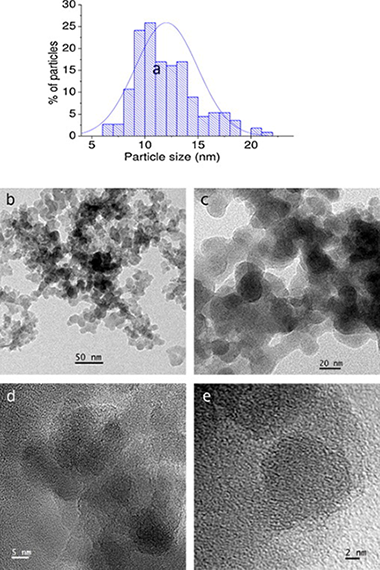
Abstract
CaO has been deposited on a nanosilica powder matrix by a procedure based on atomic layer deposition (ALD) in a fluidized bed reactor at atmospheric pressure following a potentially scalable process. In previous works ALD in gas fluidized bed has been mostly performed under reduced pressure, which hampers scaling-up the production technology. The material synthesized in the present work is tested as CO2 solid sorbent at calcium looping conditions. Multicyclic thermogravimetric analysis (TGA) shows that the nanosilica support stabilizes the capture capacity of CaO. EDX-STEM analysis illustrates the presence of Ca well distributed on the surface of the SiO2 nanoparticles.
February, 2015 · DOI: 10.1016/j.apsusc.2014.12.106
Química de Superficies y Catálisis
Glycerol steam reforming on bimetallic NiSn/CeO2-MgO-Al2O3 catalysts: Influence of the support, reaction parameters and deactivation/regeneration processes
Bobadilla, LP; Penkova, A; Alvarez, A; Dominguez, MI; Romero-Sarria, F; Centeno, MA; Odriozola, JAApplied Catalysis A: General, 492 (2015) 38-47 DOI: 10.1016/j.apcata.2014.12.029
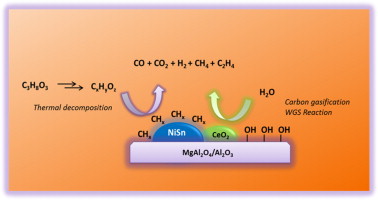
Abstract
NiSn bimetallic catalysts supported over Al2O3 modified with different promoter (Mg and/or Ce) were prepared and characterized by powder X-ray diffraction (XRD), N2 sorptometry, and temperature programmed reduction (TPR). Hydrogen production by glycerol steam reforming over these catalysts was investigated. Among the catalysts, NiSn/AlMgCe catalyst shows the highest hydrogen yield as well as the best stability during the reaction. The effect of reaction temperature, water/glycerol molar ratio and space velocity on the glycerol steam reforming over NiSn/AlMgCe were also investigated. Finally, it was verified that the catalyst can be regenerated by oxidation of carbonaceous deposits.
February, 2015 · DOI: 10.1016/j.apcata.2014.12.029
Materiales y Procesos Catalíticos de Interés Ambiental y Energético
Water splitting performance of Er3+-doped YVO4 prepared from a layered K3V5O14 precursor
Obregon, S; Colon, GChemical Engineering Journal, 262 (2015) 29-33 DOI: 10.1016/j.cej.2014.09.073
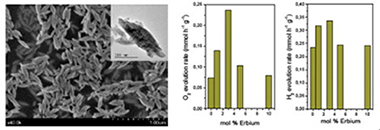
Abstract
Erbium-doped YVO4 have been synthesized by means of a simple solution method having good photo activities under UV-like excitation for the water splitting half reactions. From the structural and morphological characterization it has been stated that the presence of Er3+ induces the promotion of luminescence. Moreover the incorporation of erbium clearly affects to the morphology YVO4 leading to 200 nm size well-defined spindle-like particles. The improved photocatalytic performance might be associated to a better electron–hole separation mechanism, probably due to the slight increase of band-gap value. The obtained photoactivities for H2 and O2 evolution reactions make this material a promising candidate for water splitting reactions.
February, 2015 · DOI: 10.1016/j.cej.2014.09.073
Química de Superficies y Catálisis - Fotocatálisis Heterogénea: Aplicaciones
Synthesis and application of layered titanates in the photocatalytic degradation of phenol
Ivanova, S; Penkova, A; Hidalgo, MD; Navio, JA; Romero-Sarria, F; Centeno, MA; Odriozola, JAApplied Catalysis B: Environmental, 163 (2015) 23-29 DOI: 10.1016/j.apcatb.2014.07.048
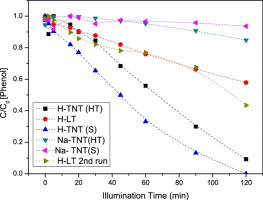
Abstract
This study proposes a direct synthetic route to single titanate sheets through the mild and versatile conditions of the “chimie douce”. The stages of the production include the complexation of the titanium alkoxide precursor by benzoic acid, the formation of titanium oxo-clusters and their controlled transformation into single sheet titanates during the hydrolysis stage. The resulted material appears to be an excellent precursor for self-organized TiO2 nanotubes formation which presents an excellent activity as photocatalyst in the photo-degradation of phenol.
February, 2015 · DOI: 10.1016/j.apcatb.2014.07.048
Reactividad de Sólidos
Influence of the Processing Route on the Carbon Nanotubes Dispersion and Creep Resistance of 3YTZP/SWCNTs Nanocomposites
Castillo-Rodriguez, M; Munoz, A; Morales-Rodriguez, A; Poyato, R; Gallardo-Lopez, A; Dominguez-Rodriguez, AJournal of the American Ceramic Society, 98 (2015) 645-653 DOI: 10.1111/jace.13348
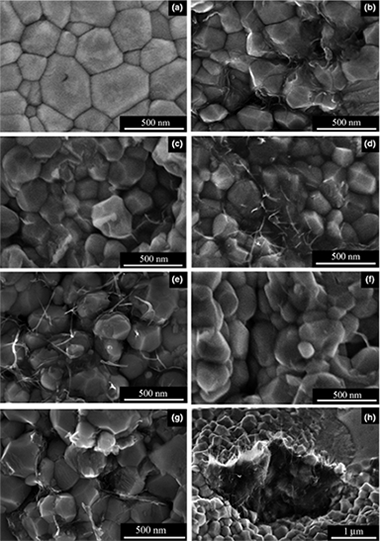
Abstract
3YTZP matrix composites containing 2.5 vol% of single-walled carbon nanotubes (SWCNT) were fabricated by Spark Plasma Sintering (SPS) at 1250°C, following different processing routines with the aim of optimizing the SWCNTs dispersion throughout the ceramic matrix. Microstructural characterization of the as-fabricated samples has been performed by means of scanning electron microscopy (SEM). The specimens have been crept at 1200°C to correlate creep resistance and SWCNTs distribution. There are no creep experimental results on these nanocomposites reported in literature. Mechanical results show that the incorporation of SWCNTs into a 3YTZP matrix produces an increase in the strain rate at high temperature with respect to monolithic zirconia. The creep resistance of these nanocomposites decreases with the improvement of the SWCNTs dispersion, where a smaller SWCNTs agglomerate size and consequently a higher concentration of carbon nanotubes surrounding the 3YTZP grain boundaries is found. This fact indicates that SWCNTs act as a lubricant making grain-boundary sliding easier during deformation of these composites.
February, 2015 · DOI: 10.1111/jace.13348
Nanotecnología en Superficies y Plasma - Materiales Nanoestructurados y Microestructura
STEM-EELS analysis reveals stable highdensity He in nanopores of amorphous silicon coatings deposited by magnetron sputtering
Schierholz, Roland; Lacroix, Bertrand; Godinho, Vanda; Caballero-Hernandez, Jaime; Duchamp, Martial; Fernandez, AsuncionNanotechnology, 26 (2015) 075703 DOI: 10.1088/0957-4484/26/7/075703
Abstract
A broad interest has been showed recently on the study of nanostructuring of thin films and surfaces obtained by low-energy He plasma treatments and He incorporation via magnetron sputtering. In this paper spatially resolved electron energy-loss spectroscopy in a scanning transmission electron microscope is used to locate and characterize the He state in nanoporous amorphous silicon coatings deposited by magnetron sputtering. A dedicated MATLAB program was developed to quantify the helium density inside individual pores based on the energy position shift or peak intensity of the He K-edge. A good agreement was observed between the high density (~35–60 at nm−3) and pressure (0.3–1.0 GPa) values obtained in nanoscale analysis and the values derived from macroscopic measurements (the composition obtained by proton backscattering spectroscopy coupled to the macroscopic porosity estimated from ellipsometry). This work provides new insights into these novel porous coatings, providing evidence of high-density He located inside the pores and validating the methodology applied here to characterize the formation of pores filled with the helium process gas during deposition. A similar stabilization of condensed He bubbles has been previously demonstrated by high-energy He ion implantation in metals and is newly demonstrated here using a widely employed methodology, magnetron sputtering, for achieving coatings with a high density of homogeneously distributed pores and He storage capacities as high as 21 at%.
February, 2015 · DOI: 10.1088/0957-4484/26/7/075703
Materiales de Diseño para la Energía y Medioambiente
Long-Chain Polyhydroxyesters from Natural Occurring Aleuritic Acid as Potential Material for Food Packaging
Benitez, JJ; Heredia-Guerrero, JA; Guzman-Puyol, S; Dominguez, E; Heredia, ASoft Materials, 13 (2015) 5-11 DOI: 10.1080/1539445X.2014.993476

Abstract
Fatty polyhydroxyesters (C≥16) are present in nature as barrier polymers like cutin in some protective tissues of higher plants. The mimicry of these biopolymers is regarded as a strategy to design nontoxic and fully biodegradable food packaging films and coatings. To obtain cutin inspired materials we have used a natural occurring polyhydroxylated monomer like aleuritic (9,10,16-trihydroxypalmitic) acid and a direct and scalable synthesis route consisting in the noncatalyzed melt-condensation polymerization in air. To reduce the number of hydroxyl groups and to increase hydrophobicity, palmitic acid has been used as a capping agent. Aleuritic-palmitic polyhydroxyesteres films have been obtained and characterized.
January, 2015 · DOI: 10.1080/1539445X.2014.993476
Materiales Nanoestructurados y Microestructura
Biotribological behavior of Ag–ZrCxN1−x coatings against UHMWPE for joint prostheses devices
Calderon, SV; Sanchez-Lopez, JC; Cavaleiro, A; Carvalho, SJournal of the Mechanical Behavior of Biomedical Materials, 41 (2015) 83-91 DOI: 10.1016/j.jmbbm.2014.09.028
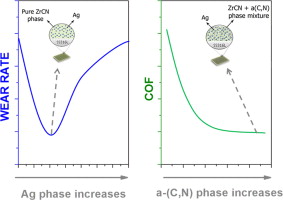
Abstract
This study aims to evaluate the structural, mechanical and tribological properties of zirconium carbonitrides (ZrCxN1−x) coatings with embedded silver nanoparticles, produced with the intention of achieving a material with enhanced multi-functional properties, including mechanical strength, corrosion resistance, tribological performance and antibacterial behavior suitable for their use in joint prostheses. The coatings were deposited by direct current (DC) reactive magnetron sputtering onto 316 L stainless steel, changing the silver content from 0 to 20 at% by modifying the current density applied to the targets. Different nitrogen and acetylene gas fluxes were used as reactive gases. The coatings revealed different mixtures of crystalline ZrCxN1−x, silver nanoparticles and amorphous carbon phases. The hardness of the films was found to be mainly controlled by the ratio between the hard (ZrCxN1−x) and soft (Ag and amorphous carbon) phases in the films, fluctuating between 7.4 and 20.4 GPa. The coefficient of friction, measured against ultra-high molecular weight polyethylene (UHMWPE) in Hank’s balanced salt solution with 10 g L−1albumin, is governed by the surface roughness and hardness. The UHMWPE wear rates were in the same order of magnitude (between 1.4 and 2.0×10−6 mm3 N−1 m−1), justified by the effect of the protective layer of albumin formed during the tests. The small differences were due to the hydrophobic/hydrophilic character of the surface, as well as to the silver content.
January, 2015 · DOI: 10.1016/j.jmbbm.2014.09.028
Reactividad de Sólidos
Uniform, luminescent Eu: LuF3 nanoparticles
Becerro, AI; Gonzalez-Mancebo, D; Ocana, MJournal of Nanoparticle Research, 17 (2015) 58 DOI: 10.1007/s11051-015-2874-z
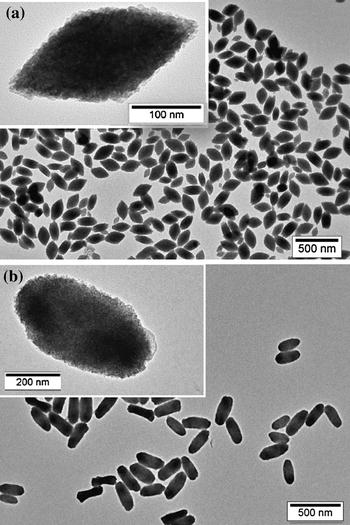
Abstract
A simple procedure for the synthesis of orthorhombic, uniform, LuF3 particles with two different morphologies (rhombus- and cocoon-like) and nanometer and sub-micrometer size, respectively, is reported. The method consists in the aging, at 120 °C for 2 h, a solution containing [BMIM]BF4 ionic liquid (0.5 mL) and lutetium acetate (in the case of the rhombi) or lutetium nitrate (in the case of the cocoons) (0.02 M) in ethylene glycol (total volume 10 mL). This synthesis method was also adequate for the synthesis of Eu3+-doped LuF3 particles of both morphologies, whose luminescence properties were investigated in detail. The experimental observations reported herein suggest that these materials are suitable phosphors for optoelectronic as well as in vitro biotechnological applications.
January, 2015 · DOI: 10.1007/s11051-015-2874-z
Nanotecnología en Superficies y Plasma
Effect of magnesium and titanium on the cathodic behaviour of aluminium in nitric acid
Garcia-Garcia, FJ, Chiu, TY, Skeldon, P, Thompson, GESurface and Interface Analysis, 47 (2015) 30-36 DOI: 10.1002/sia.5640
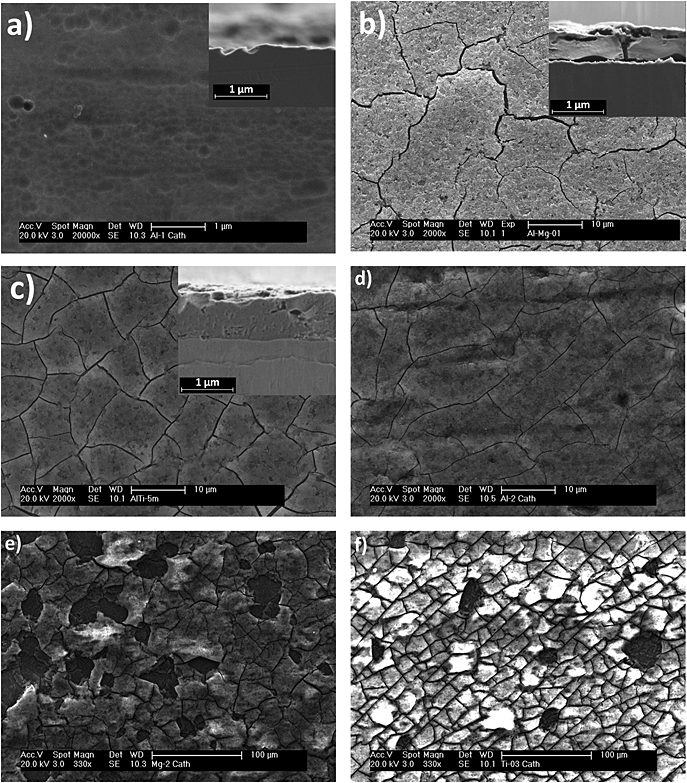
Abstract
Cathodic polarization of aluminium and Al-0.18wt.%Mg and Al-0.08wt.% Ti alloys in 0.24moldm(-3) nitric acid solution at 38 degrees C has been employed to assist understanding of the roles of alloying elements in electrograining. The findings indicate that additions of magnesium and titanium to aluminium accelerate the corrosion of the substrate under the alkalization caused by the cathodic reactions. The accelerated dissolution and the consequent formation of hydrated alumina result in a decreased net cathodic current density in potentiostatic and potentiodynamic polarization conditions relative to the behaviour of aluminium.
January, 2015 · DOI: 10.1002/sia.5640
Materiales Coloidales
Quick synthesis, functionalization and properties of uniform, luminescent LuPO4-based nanoparticles
Becerro, AI; Ocana, MRSC Advances, 44 (2015) 34517-34524 DOI: 10.1039/C5RA05305F
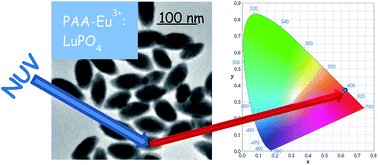
Abstract
The aim of this study was to find a surfactant-free method for the synthesis of uniform Eu:LuPO4nanophosphors which are able to form stable colloidal suspensions in aqueous media. Uniform, ovoid Eu-doped LuPO4 fluorescent nanoparticles were obtained after aging for 30 minutes at 180 °C a butylene glycol solution containing, exclusively, lutetium acetate, europium acetate and H3PO4. XRD and digital diffraction patterns of HRTEM images suggested that the particles were single crystalline in nature with the c-axis of the unit cell parallel to the long particle axis. The luminescence study revealed that the optimum doping level was 5 molar%. The latter particles (85 nm × 40 nm dimensions) were functionalized with polyacrylic acid and their colloidal stability in two different biological buffers was demonstrated to persist for at least 15 days.
January, 2015 · DOI: 10.1039/C5RA05305F
Materiales Coloidales
Template-free synthesis and luminescent properties of hollow Ln:YOF (Ln = Eu or Er plus Yb) microspheres
Martinez-Castro, E; Garcia-Sevillano, J; Cusso, F; Ocana, MJournal of Alloys and Compounds, 619 (2015) 44-51 DOI: 10.1016/j.jallcom.2014.09.023
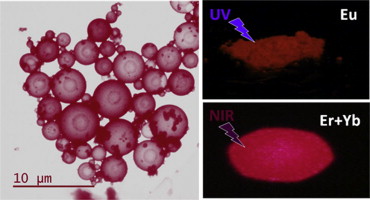
Abstract
A method for the synthesis of hollow lanthanide doped yttrium oxyfluoride (YOF) spheres in the micrometer size range with cubic structure based on the pyrolysis at 600 degrees C of liquid aerosols generated from aqueous solutions containing the corresponding rare earth chlorides and trifluoroacetic acid has been developed. This procedure, which has been used for the first time for the synthesis of YFO based materials, is simpler and advantageous when compared with other methods usually employed for the production of hollow spheres since it does not require the use of sacrificial templates. In addition, it is continuous, which is desirable because of practical reasons. The procedure is also suitable for doping the YOF spheres with europium cations resulting in down converting red phosphors when activated with UV light, or for co-doping with both Er3+ and Yb3+ giving rise to up-converting phosphors, which emit intense red light under near infrared (NIR) irradiation. Because of their optical properties and hollow architecture, the developed materials may find applications in optoelectronic devices and biotechnology.
January, 2015 · DOI: 10.1016/j.jallcom.2014.09.023
Nanotecnología en Superficies y Plasma - Materiales y Procesos Catalíticos de Interés Ambiental y Energético
Sonogashira Cross-Coupling and Homocoupling on a Silver Surface: Chlorobenzene and Phenylacetylene on Ag(100)
Sanchez-Sanchez, C; Orozco, N; Holgado, JP; Beaumont, SK; Kyriakou, G; Watson, DJ; Gonzalez-Elipe, AR; Feria, L; Sanz, JF; Lambert, RMJournal of the American Chemical Society, 137 (2015) 940-947 DOI: 10.1021/ja5115584
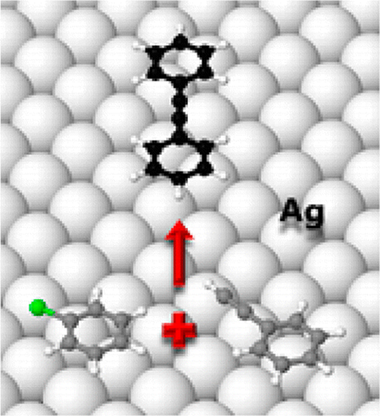
Abstract
Scanning tunneling microscopy, temperature-programmed reaction, near-edge X-ray absorption fine structure spectroscopy, and density functional theory calculations were used to study the adsorption and reactions of phenylacetylene and chlorobenzene on Ag(100). In the absence of solvent molecules and additives, these molecules underwent homocoupling and Sonogashira cross-coupling in an unambiguously heterogeneous mode. Of particular interest is the use of silver, previously unexplored, and chlorobenzene—normally regarded as relatively inert in such reactions. Both molecules adopt an essentially flat-lying conformation for which the observed and calculated adsorption energies are in reasonable agreement. Their magnitudes indicate that in both cases adsorption is predominantly due to dispersion forces for which interaction nevertheless leads to chemical activation and reaction. Both adsorbates exhibited pronounced island formation, thought to limit chemical activity under the conditions used and posited to occur at island boundaries, as was indeed observed in the case of phenylacetylene. The implications of these findings for the development of practical catalytic systems are considered.
January, 2015 · DOI: 10.1021/ja5115584
Materiales Ópticos Multifuncionales
Optical Description of Mesostructured Organic-Inorganic Halide Perovskite Solar Cells
Anaya, M; Lozano, G; Calvo, ME; Zhang, W; Johnston, MB; Snaith, HJ; Miguez, HJournal of Physical Chemistry Letters, 6 (2015) 48-53 DOI: 10.1021/jz502351s
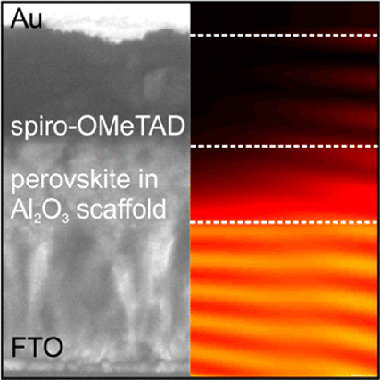
Abstract
Herein we describe both theoretically and experimentally the optical response of solution-processed organic–inorganic halide perovskite solar cells based on mesostructured scaffolds. We develop a rigorous theoretical model using a method based on the propagation of waves in layered media, which allows visualizing the way in which light is spatially distributed across the device and serves to quantify the fraction of light absorbed by each medium comprising the cell. The discrimination between productive and parasitic absorption yields an accurate determination of the internal quantum efficiency. State-of-the-art devices integrating mesoporous scaffolds infiltrated with perovskite are manufactured and characterized to support the calculations. This combined experimental and theoretical analysis provides a rational understanding of the optical behavior of perovskite cells and can be beneficial for the judicious design of devices with improved performance. Notably, our model justifies the presence of a solid perovskite capping layer in all of the highest efficiency perovskite solar cells based on thinner mesoporous scaffolds.
January, 2015 · DOI: 10.1021/jz502351s
Química de Superficies y Catálisis
Catalytic screening of Au/CeO2-MOx/Al2O3 catalysts (M = La, Ni, Cu, Fe, Cr, Y) in the CO-PrOx reaction
Reina, TR; Ivanova, S; Centeno, MA; Odriozola, JAInternational Journal of Hydrogen Energy, 40 (2015) 1782-1788 DOI: 10.1016/j.ijhydene.2014.11.141
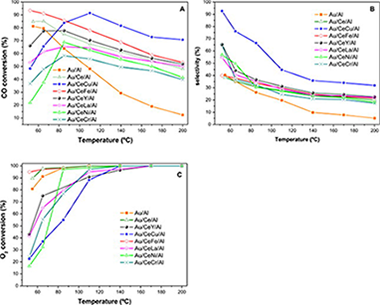
Abstract
In this work, a series of Au/CeO2-MOx/Al2O3 catalysts has been prepared and evaluated in the PrOx reaction. Within the series of dopants Fe and Cu containing samples enhanced the catalytic performance of the parent Au/CeO2/Al2O3 catalyst being copper the most efficient promoter. For both samples an enhanced oxygen storage capacity (OSC) is registered and accounts for the high CO oxidation activity. More particularly, the Au/CeO2-CuOx/Al2O3 catalyst successfully withstands the inclusion of water in the PrOx stream and presents good results in terms of CO elimination. However to achieve a good selectivity toward, CO2 formation properly adjusting of the reaction parameters, such as oxygen concentration and space velocity is needed. Within the whole screened series the Cu-containing catalyst can be considered as the most interesting alternative for H-2 clean-up applications.
January, 2015 · DOI: 10.1016/j.ijhydene.2014.11.141
Reactividad de Sólidos
New Insights on the Kinetic Analysis of Isothermal Data: The Independence of the Activation Energy from the Assumed Kinetic Model
Sanchez-Jimenez, PE; Perejon, A; Perez-Maqueda, LA; Criado, JMEnergy & Fuels, 29 (2015) 392-397 DOI: 10.1021/ef502269r
Abstract
Isothermal experiments are widely employed to study the kinetics of solid-state reactions or processes to extract essential kinetic information needed for modeling the processes at an industrial scale. The kinetic analysis of isothermal data requires finding or assuming a kinetic function that can properly fit the evolution of the reaction rate with time, so that the resulting parameters, i.e., the activation energy and pre-exponential factor, can be considered reliable. In the present work, we demonstrate using both simulated and experimental data that the kinetic analysis of a set of isothermal plots obtained at different temperatures, considering a single-step solid-state reaction, necessarily leads to the real activation energy, regardless the mathematical function selected for performing the kinetic analysis. This makes irrelevant the election of the kinetic function used to fit the experimental data and greatly facilitates the estimation of the activation energy for any single process.
January, 2015 · DOI: 10.1021/ef502269r
Reactividad de Sólidos
Limestone Calcination Nearby Equilibrium: Kinetics, CaO Crystal Structure, Sintering and Reactivity
Valverde, JM; Sanchez-Jimenez, PE; Perez-Maqueda, LAJournal of Physical Chemistry C, 119 (2015) 1523-1541 DOI: 10.1021/jp508745u
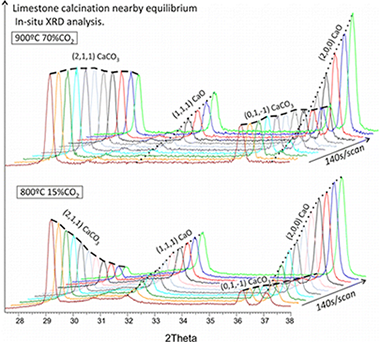
Abstract
In this work, we analyze limestone calcination kinetics at environmental conditions involving a CO2 partial pressure P close to the equilibrium pressure Peq by means of in situ X-ray diffraction (XRD) and thermogravimetric (TG) analyses. In contrast with previous empirical observations carried out mostly at conditions far from equilibrium (P/Peq ≪ 1), our results show that the decarbonation rate decreases as the temperature in increased while P/Peq is kept constant, which is explained from a reaction mechanism including desorption of CO2 and the exothermic structural transformation from metastable CaO* nanocrystals to the stable CaO form. The crystal structure and sintering of nascent CaO during calcination has been investigated from in situ XRD analysis, physisorption analysis, and scanning electron microscopy (SEM), which shows that the ratio of the size of polycrystalline CaO grains to crystallite size increases linearly with the CO2 partial pressure in the calcination atmosphere. For high CO2 partial pressures, the size of CaO grains reaches a maximum value of around 1 μm, which leads to a residual surface area of about 1 m2/g, whereas in the limit P → 0 grain size and crystallite size (of the order of 10 nm) would coincide. Accordingly, sintering in the presence of CO2 would be triggered by the agglomeration of CaO crystals enhanced by CO2adsorption, which increases the surface energy. The carbonation reactivity of CaO resulting from calcination scales proportionally to its surface area and is not determined by a growth of the CaO exposed surface along a preferred crystallographic direction wherein carbonation would be unfavorable as suggested in recent works.
January, 2015 · DOI: 10.1021/jp508745u
2014
2014
Nanotecnología en Superficies y Plasma
Quinone-Rich Poly(dopamine) Magnetic Nanoparticles for Biosensor Applications
Martin, M; Orive, AG; Lorenzo-Luis, P; Creus, AH; Gonzalez-Mora, JL; Salazar, PChemPhysChem, 15 (2014) 3742-3752 DOI: 10.1002/cphc.201402417
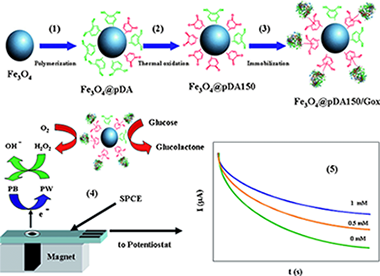
Abstract
Novel core-shell quinone-rich poly(dopamine)–magnetic nanoparticles (MNPs) were prepared by using an in situ polymerization method. Catechol groups were oxidized to quinone by using a thermal treatment. MNPs were characterized by using X-ray diffraction, X-ray photoelectron spectroscopy, atomic force microscopy, magnetic force microscopy, UV/Vis, Fourier-transform infrared spectroscopy, and electrochemical techniques. The hybrid nanomaterial showed an average core diameter of 17 nm and a polymer-film thickness of 2 nm. The core-shell nanoparticles showed high reactivity and were used as solid supports for the covalent immobilization of glucose oxidase (Gox) through Schiff base formation and Michael addition. The amount of Gox immobilized onto the nanoparticle surface was almost twice that of the nonoxidized film. The resulting biofunctionalized MNPs were used to construct an amperometric biosensor for glucose. The enzyme biosensor has a sensitivity of 8.7 mA m−1 cm−2, a low limit of detection (0.02 mm), and high stability for 45 days. Finally, the biosensor was used to determine glucose in blood samples and was checked against a commercial glucometer.
December, 2014 · DOI: 10.1002/cphc.201402417
Propiedades mecánicas, modelización y caracterización de cerámicos avanzados
High temperature internal friction measurements of 3YTZP zirconia polycrystals. High temperature background and creep
Simas, P; Castillo-Rodriguez, M; No, ML; De-Bernardi, S; Gomez-Garcia, D; Dominguez-Rodriguez, A; Juan, JSJournal of the European Ceramic Society, 34 (2014) 3859-3863 DOI: 10.1016/j.jeurceramsoc.2014.05.016
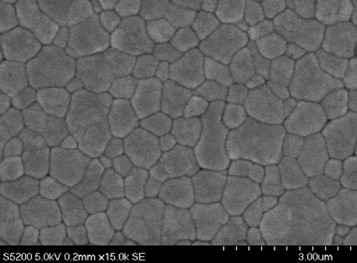
Abstract
This work focuses on the high-temperature mechanic properties of a 3 mol% yttria zirconia polycrystals (3YTZP), fabricated by hot-pressureless sintering. Systematic measurements of mechanical loss as a function of temperature and frequency were performed. An analytical method, based on the generalized Maxwell rheological model, has been used to analyze the high temperature internal friction background (HTB). This method has been previously applied to intermetallic compounds but never to ceramics, except in a preliminary study performed on fine grain and nanocrystalline zirconia. The HTB increases exponentially and its analysis provides an apparent activation enthalpy which correlates well with that obtained from creep experiments. This fact shows on the one hand the plausibility of applying the generalized Maxwell model to ceramics, and on the other hand indicates the possibility of using mechanical spectroscopy as a complementary helpful technique to investigate the high temperature deformation mechanism of materials.
December, 2014 · DOI: 10.1016/j.jeurceramsoc.2014.05.016
Nanotecnología en Superficies y Plasma
Transmission electron microscopy of unstained hybrid Au nanoparticles capped with PPAA (plasma-poly-allylamine): Structure and electron irradiation effects
Gontard, LC; Fernandez, A; Dunin-Borkowski, RE; Kasama, T; Lozano-Perez, S; Lucas, SMicron, 67 (2014) 1-9 DOI: 10.1016/j.micron.2014.06.004

Abstract
Hybrid (organic shell–inorganic core) nanoparticles have important applications in nanomedicine. Although the inorganic components of hybrid nanoparticles can be characterized readily using conventional transmission electron microscopy (TEM) techniques, the structural and chemical arrangement of the organic molecular components remains largely unknown. Here, we apply TEM to the physico-chemical characterization of Au nanoparticles that are coated with plasma-polymerized-allylamine, an organic compound with the formula C3H5NH2. We discuss the use of energy-filtered TEM in the low-energy-loss range as a contrast enhancement mechanism for imaging the organic shells of such particles. We also study electron-beam-induced crystallization and amorphization of the shells and the formation of graphitic-like layers that contain both C and N. The resistance of the samples to irradiation by high-energy electrons, which is relevant for optical tuning and for understanding the degree to which such hybrid nanostructures are stable in the presence of biomedical radiation, is also discussed.
December, 2014 · DOI: 10.1016/j.micron.2014.06.004
Materiales Coloidales
One-Step Synthesis and Polyacrylic Acid Functionalization of Multifunctional Europium-Doped NaGdF4 Nanoparticles with Selected Size for Optical and MRI Imaging
Nunez, NO; Garcia, M; Garcia-Sevillano, J; Rivera-Fernandez, S; de la Fuente, JM; Ocana, MEuropean Journal of Inorganic Chemistry, 35 (2014) 6075-6084 DOI: 10.1002/ejic.201402690
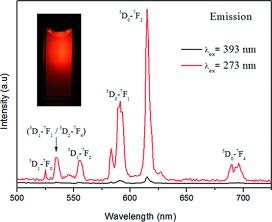
Abstract
Multifunctional Eu:NaGdF4 nanospheres functionalized with polyacrylic acid (PAA) polymer have been prepared for the first time by a simple one-pot method that consists of a homogeneous precipitation reaction at 120 °C. The size of the nanospheres, which were polycrystalline and crystallized into a hexagonal structure, could be altered in the 60–95 nm range by adjusting the amount of polyacrylic acid added. The effects of Eu content and particle size of these nanomaterials on their optical properties (emission intensity and lifetime) as well as on their relaxivity (r1 and r2) values were also analyzed to find the optimum system for optical bioimaging and as a positive contrast agent for magnetic resonance imaging (MRI) applications. Finally, such optimum nanoparticles showed negligible cytotoxicity for Vero cells for concentrations up to 0.5 mg mL–1 and a high colloidal stability in 2-morpholinoethanesulfonic acid solutions, thereby satisfying the most important requirements for their use in biotechnological applications.
December, 2014 · DOI: 10.1002/ejic.201402690
Nanotecnología en Superficies y Plasma
LMM Auger primary excitation spectra of copper
Pauly, N; Tougaard, S; Yubero, FSurface Science, 630 (2014) 294-299 DOI: 10.1016/j.susc.2014.08.029
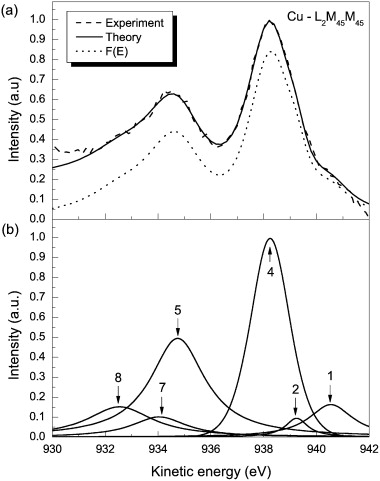
Abstract
The shape and intensity of measured Auger peaks are strongly affected by extrinsic excitations due to electron transport out of the surface and to intrinsic excitations induced by the sudden creation of the two static core holes. Following a method developed for XPS in a previous work [N. Pauly, S. Tougaard, F. Yubero, Surf. Sci. 620 (2014) 17], we have calculated the effective energy-differential inelastic electron scattering cross-sections, including the effects of the surface and of the two core holes, within the dielectric response theory by means of the QUEELS-XPS software (QUantitative analysis of Electron Energy Losses at Surfaces for XPS). The Auger spectra are then modeled by convoluting this energy loss cross section with the primary excitation spectrum that accounts for all effects which are part of the initial Auger process, i.e. L–S coupling and vacancy satellite effects. The shape of this primary excitation spectrum is fitted to get close agreement between the theoretical and the experimental spectra obtained from X-ray excited Auger electron spectroscopy (XAES). We have performed these calculations of XAES spectra for various LMM Auger transitions of pure Cu (L3M45M45, L3M23M45, L3M23M23 and L2M45M45 transitions). We compare the resulting primary excitation spectra with theoretical results published in the literature and obtain reasonable quantitative agreement. In particular, we extract from experimental spectra quantitative intensities due to Coster–Kronig, shake-off and shake-up processes relative to the intensity from the “normal” Auger process.
December, 2014 · DOI: 10.1016/j.susc.2014.08.029
Reactividad de Sólidos
Role of precalcination and regeneration conditions on postcombustion CO2 capture in the Ca-looping technology
Valverde, JM; Sanchez-Jimenez, PE; Perez-Maqueda, LAApplied Energy, 136 (2014) 347-356 DOI: 10.1016/j.apenergy.2014.09.052
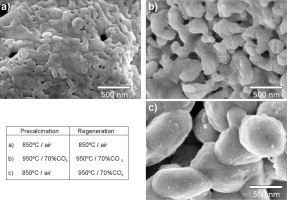
Abstract
The Ca-looping (CaL) technology is already recognized as a potentially viable method to capture CO2 from postcombustion gas in coal fired power plants. In this process, CO2 is chemisorbed by CaO solid particles derived from precalcination of cheap and widely available natural limestone. The partially carbonated solids are regenerated by calcination under high CO2 concentration. Novel CaL concepts are proposed to further improve the efficiency of the technology such as the introduction of a recarbonation reactor in between the carbonation and calcination stages to mitigate the progressive deactivation of the regenerated CaO. Process simulations aimed at retrieving optimum design parameters and operating conditions to scale-up the technology yield results critically dependent on the multicyclic sorbent performance. Nevertheless, technical limitations usually preclude lab-scale tests from mimicking realistic CaL conditions necessarily involving high CO2 concentration for sorbent regeneration and quick transitions between carbonation and calcination. In this work, a lab-scale experimental analysis is reported on the CaO multicyclic conversion at CaL conditions closely resembling those to be expected in practice. The results presented evidence a relevant role of precalcination conditions. Precalcination in air leads to a strongly adverse effect on the activity of the sorbent regenerated under high CO2 concentration, which is further hindered if a recarbonation stage is introduced. On the other hand, sorbent deactivation is mitigated if precalcination is carried out at conditions similar to those used for sorbent regeneration. In this case, recarbonation helps lessening the loss of multicyclic conversion, which is further enhanced by the synergistic combination with heat pretreatment. Moreover, the present study shows that the kinetics of carbonation is strongly dependent on precalcination and regeneration conditions. The diffusion controlled carbonation phase and recarbonation are intensified if the sorbent is precalcined and regenerated under high CO2 concentration whereas the reaction controlled carbonation phase is notably hampered.
December, 2014 · DOI: 10.1016/j.apenergy.2014.09.052
Reactividad de Sólidos
Improvement of Vickers hardness measurement on SWNT/Al2O3 composites consolidated by spark plasma sintering
Rodriguez, AM; Lopez, AG; Fernandez-Serrano, A; Poyato, R; Munoz, A; Dominguez-Rodriguez, AJournal of the European Ceramic Society, 34 (2014) 3801-3809 DOI: 10.1016/j.jeurceramsoc.2014.05.048
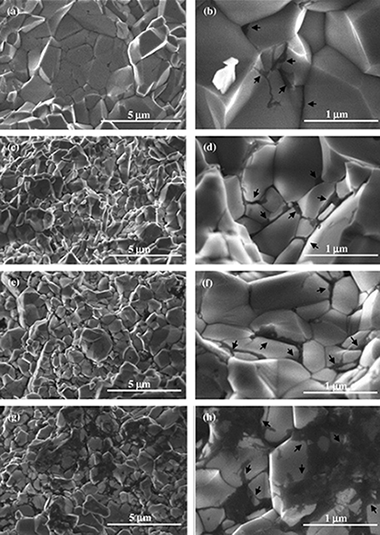
Abstract
Dense alumina composites with different carbon nanotube content were prepared by colloidal processing and consolidated by Spark Plasma Sintering (SPS). Single-wall carbon nanotubes (SWNTs) were distributed at grain boundaries and also into agglomerates homogeneously dispersed. Carrying out Vickers hardness tests on the cross-section surfaces instead of top (or bottom) surfaces has shown a noticeable increase in the reliability of the hardness measurements. This improvement has been mainly attributed to the different morphology of carbon nanotube agglomerates, which however does not seem to affect the Vickers hardness value. Composites with lower SWNT content maintain the Vickers hardness of monolithic alumina, whereas it significantly decreases for the rest of compositions. The decreasing trend with increasing SWNT content has been explained by the presence of higher SWNT quantities at grain boundaries. Based on the results obtained, a method for optimizing Vickers hardness tests performance on SWNT/Al2O3 composites sintered by SPS is proposed.
December, 2014 · DOI: 10.1016/j.jeurceramsoc.2014.05.048
Química de Superficies y Catálisis
Heterogeneous selective oxidation of fatty alcohols: Oxidation of 1-tetradecanol as a model substrate
Corberan, VC; Gomez-Aviles, A; Martinez-Gonzalez, S; Ivanova, S; Dominguez, MI; Gonzalez-Perez, MECatalysis Today, 238 (2014) 49-53 DOI: 10.1016/j.cattod.2014.03.033
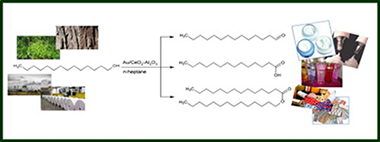
Abstract
Selective oxidation of fatty alcohols, i.e., linear long-chain alkanols, has been scarcely investigated to date, despite its potential application in high value chemical's production. We report for the first time the liquid phase heterogeneous oxidation of 1-tetradecanol, used as a model molecule for fatty alcohols, according to green chemistry principles by using a Au/CeO2-Al2O3 catalyst and O-2 as oxidant at normal pressure. High selectivity to tetradecanal (ca. 80%) or to tetradecanoic acid (60-70%) are reached at medium conversion (up to 38%), depending on the reaction conditions used. Comparison with similar tests of 1-octanol oxidation shows that the increase of the carbon chain length decreases the alcohol conversion and the formation of ester, probably due to a greater steric effect.
December, 2014 · DOI: 10.1016/j.cattod.2014.03.033
Materiales de Diseño para la Energía y Medioambiente
Enhanced activity of clays and its crucial role for the activity in ethylene polymerization
Camejo-Abreu, C; Tabernero, V; Alba, MD; Cuenca, T; Terreros, PJournal of Molecular Catalysis A-Chemical, 393 (2014) 96-104 DOI: 10.1016/j.molcata.2014.05.030
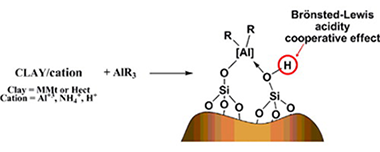
Abstract
This paper presents a study of the effects of different treatments on the polymerization activity of modified clays as cocatalysts. To achieve this goal, an intercalating cation was introduced into two smectites and these clays were then modified with trimethyl aluminium. The results for ethylene polymerization, when a zirconocene complex was used as catalyst, and the structure analysis, allow us to obtain interesting deductions about the generation mode of the active species. All active materials employed as support activators presented aluminium in a pentahedral environment together with acidic hydrogen atoms. These two features were detected only after TMA treatment and they seem to be crucial elements in active cocatalyst generation. Moreover, a material without structural aluminium displayed the best activity pointing to the new aluminium species generated in the solid matrix as the determining factor for the activity. We proposed a synergic effect between Lewis acid aluminium centres and acidic Bronsted protons that generate the SiOHAl groups that activate the zirconium compound.
November, 2014 · DOI: 10.1016/j.molcata.2014.05.030
Materiales de Diseño para la Energía y Medioambiente
Quantification and comparison of the reaction properties of FEBEX and MX-80 clays with saponite: Europium immobilisers under subcritical conditions
Villa-Alfageme, M; Hurtado, S; Castro, MA; El Mrabet, S; Orta, MM; Pazos, MC; Alba, MDApplied Clay Science, 101 (2014) 10-15 DOI: 10.1016/j.clay.2014.08.012
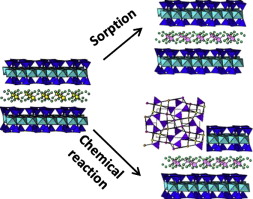
Abstract
The evaluation of the retention mechanisms in FEBEX and MX-80 bentonites, selected as reference materials to construct engineered barriers, carries major implications in the safe storage of immobilisation capacity through a recently discovered chemical retention mechanism and the structural analysis of the reaction products. Hydrothermal treatments were accomplished with immobilisation capacity through a recently discovered chemical retention mechanism and the structural analysis of the reaction products. Hydrothermal treatments were accomplished with Eu(NO3)3 (151Eu and 153Eu, with 52.2% 153Eu) and spiked with radioactive 152Eu for the quantification of the reactions. Results were compared with saponite as the reference smectite. The strong dependence of the reaction parameters with temperature and time was quantified and the reaction velocity was evaluated. The velocity follows these trends: 240 days are needed for the total retention of europium for temperatures over 200 °C; below 150 °C, significantly longer reaction times, on the order of three years, are required to complete the reaction. Clays do not influence velocity rates, but the retention capacity of bentonites remains lower than for saponite. At 300 °C, the milliequivalents retained by the three clays are consistently over CEC. The structural analyses reveal not only adsorption of europium but also the presence of Eu(OH)3 precipitation and Eu2SiO3 confirming the existence of a chemical reaction.
November, 2014 · DOI: 10.1016/j.clay.2014.08.012
Reactividad de Sólidos
Properties of mechanochemically synthesized nanocrystalline Bi2S3 particles
Dutkova, E; Sayagues, MJ; Zorkovska, A; Real, C; Balaz, P; Satka, A; Kovac, JMaterials Science in Semiconductor Processing, 27 (2014) 267-272 DOI: 10.1016/j.mssp.2014.05.057
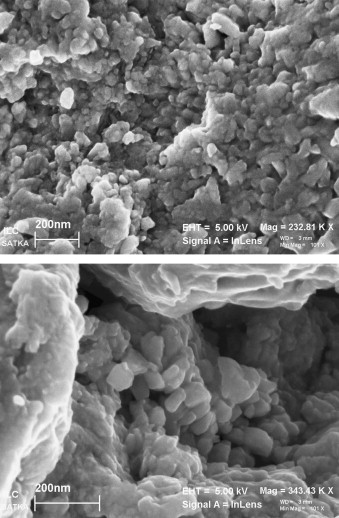
Abstract
Nanocrystalline Bi2S3 particles have been synthesized from Bi and S powders by high-energy milling in a planetary mill. Structural and microstructural characterization of the prepared particles, including phase identification, specific surface area measurement and particle size analysis has been carried out. The optical properties were measured by spectroscopic methods and the structural stability up to 500 °C was studied by thermal analysis. The production of orthorhombic Bi2S3 with crystallite size of about 26 nm was confirmed by X-ray diffraction. The nanocrystals tend to agglomerate due to their large specific surface area. Accordingly, the average hydrodynamic diameter of the mechanochemically synthesized particles is 198 nm. EDS analysis shows that the synthesized material is pure Bi2S3. The band gap of the Bi2S3 nanoparticles is 4.5 eV which is wider than that in bulk materials. The nanoparticles exhibit good luminescent properties with a peak centered at 490 and 390 nm. Differential scanning calorimetry curves exhibit a broad exothermic peak between 200 and 300 °C, suggesting recovery processes. This interpretation is supported by X-ray diffraction measurements that indicate a 10-fold increase of the crystallite size to about 230 nm. The controlled mechanochemical synthesis of Bi2S3 nanoparticles at ambient temperature and atmospheric pressure remains a great challenge.
November, 2014 · DOI: 10.1016/j.mssp.2014.05.057
Materiales Nanoestructurados y Microestructura
Chemistry, nanostructure and magnetic properties of Co-Ru-B-O nanoalloys
Arzac, GM; Rojas, TC; Gontard, LC; Chinchilla, LE; Otal, E; Crespo, P; Fernandez, ARSC Advances, 4 (2014) 46576-46586 DOI:
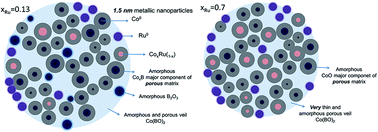
Abstract
In our previous works, Co–B–O and Co–Ru–B–O ultrafine powders with variable Ru content (xRu) were studied as catalysts for hydrogen generation through sodium borohydride hydrolysis. These materials have shown a complex nanostructure in which small Co–Ru metallic nanoparticles are embedded in an amorphous matrix formed by Co–Ru–B–O based phases and B2O3. Catalytic activity was correlated to nanostructure, surface and bulk composition. However, some questions related to these materials remain unanswered and are studied in this work. Aspects such as: 3D morphology, metal nanoparticle size, chemical and electronic information on the nanoscale (composition and oxidation states), and the study of the formation or not of a CoxRu1−x alloy or solid solution are investigated and discussed using XAS (X-ray Absorption Spectroscopy) and Scanning Transmission Electron Microscopy (STEM) techniques. Also magnetic behavior of the series is studied for the first time and the structure–performance relationships discussed. All Co-containing samples exhibited ferromagnetic behavior up to room temperature while the Ru–B–O sample is diamagnetic. For the xRu = 0.13 sample, an enhancement in the Hc (coercitive field) and Ms (saturation magnetization) is produced with respect to the monometallic Co–B–O material. However this effect is not observed for samples with higher Ru content. The presence of the CoxB-rich (cobalt boride) amorphous ferromagnetic matrix, very small metal nanoparticles (Co and CoxRu(1−x)) embedded in the matrix, and the antiferromagnetic CoO phase (for the higher Ru content sample, xRu = 0.7), explain the magnetic behavior of the series.
November, 2014 · DOI:
Materiales de Diseño para la Energía y Medioambiente
Ceramic Barrier Layers for Flexible Thin Film Solar Cells on Metallic Substrates: A Laboratory Scale Study for Process Optimization and Barrier Layer Properties
Delgado-Sanchez, JM; Guilera, N; Francesch, L; Alba, MD; Lopez, L; Sanchez, EACS Applied Materials & Interfaces, 6 (2014) 18543-18549 DOI: 10.1021/am504923z

Abstract
Flexible thin film solar cells are an alternative to both utility-scale and building integrated photovoltaic installations. The fabrication of these devices over electrically conducting low-cost foils requires the deposition of dielectric barrier layers to flatten the substrate surface, provide electrical isolation between the substrate and the device, and avoid the diffusion of metal impurities during the relatively high temperatures required to deposit the rest of the solar cell device layers. The typical roughness of low-cost stainless-steel foils is in the hundred-nanometer range, which is comparable or larger than the thin film layers comprising the device and this may result in electrical shunts that decrease solar cell performance. This manuscript assesses the properties of different single-layer and bilayer structures containing ceramics inks formulations based on Al2O3, AlN, or Si3N4 nanoparticles and deposited over stainless-steel foils using a rotogravure printing process. The best control of the substrate roughness was achieved for bilayers of Al2O3 or AlN with mixed particle size, which reduced the roughness and prevented the diffusion of metals impurities but AlN bilayers exhibited as well the best electrical insulation properties.
November, 2014 · DOI: 10.1021/am504923z
Reactividad de Sólidos
Thermal Stability of Multiferroic BiFeO3: Kinetic Nature of the beta-gamma Transition and Peritectic Decomposition
Perejon, A; Sanchez-Jimenez, PE; Criado, JM; Perez-Maqueda, LAJournal of Physical Chemistry C, 118 (2014) 26387-26395 DOI: 10.1021/jp507831j
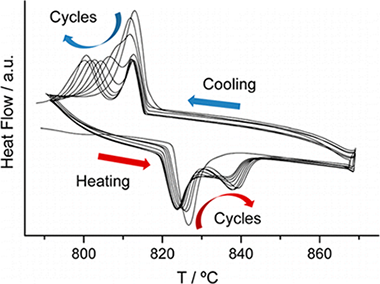
Abstract
The thermal stability of BiFeO3 prepared by mechanosynthesis and sintered at 850 °C has been studied by DSC as a function of the atmosphere and temperature. It has been found that neither the phase transitions nor the thermal stability of BiFeO3 is affected by the atmosphere in which the heating process is performed. The material is unstable above the α–β transition (TC) and slowly decomposes to produce Bi2O3 and Bi2Fe4O9. The kinetics of this slow process has been studied by performing heating–cooling DSC cycles, concluding it follows an Avrami–Erofeev nucleation and growth kinetic model. The β–γ transition and the peritectic decomposition of BiFeO3 overlap and are kinetically controlled. The kinetics of this complex process has been studied for the first time employing a new kinetic analysis procedure implying the deconvolution and subsequent analysis of the individual contributing stages. Thus, it has been demonstrated that the decomposition of BiFeO3 is accelerated when the sample is heated above the β–γ transition and both processes also follow Avrami–Erofeev kinetic models.
November, 2014 · DOI: 10.1021/jp507831j
Materiales de Diseño para la Energía y Medioambiente
Characterization of porous graphitic monoliths from pyrolyzed wood
Gutierrez-Pardo, A; Ramirez-Rico, J; de Arellano-Lopez, AR; Martinez-Fernandez, JJournal of Materials Science, 49 (2014) 7688-7696 DOI: 0.1007/s10853-014-8477-8
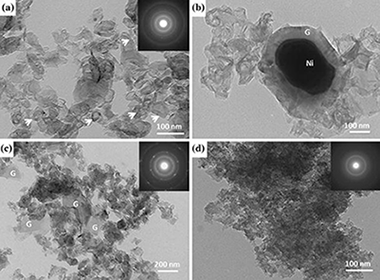
Abstract
Porous graphitic carbons were obtained from wood precursors using Ni as a graphitization catalyst during pyrolysis. The structure of the resulting material retains that of the original wood precursors with highly aligned, hierarchical porosity. Thermal characterization was performed by means of thermogravimetry and differential scanning calorimetry, and the onset temperature for graphitization was determined to be similar to 900 A degrees C. Structural and microstructural characterization was performed by means of electron microscopy, electron and x-ray diffraction, and Raman spectroscopy. The effect of maximum pyrolysis temperature on the degree of graphitization was assessed. No significant temperature effect was detected by means of Raman scattering in the range of 1000-1400 A degrees C, but at temperatures over the melting point of the catalyst, the formation of graphite grains with long-range order was detected.
November, 2014 · DOI: 0.1007/s10853-014-8477-8
Materiales Nanoestructurados y Microestructura
Tribological comparison of different C-based coatings in lubricated and unlubricated conditions
Ciarsolo, I; Fernandez, X; de Gopegui, UR; Zubizarreta, C; Abad, MD; Mariscal, A; Caretti, I; Jimenez, I; Sanchez-Lopez, JCSurface and Coatings Technology, 257 (2014) 278-285 DOI: 10.1016/j.surfcoat.2014.07.068
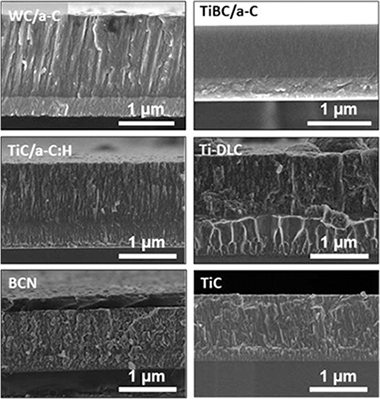
Abstract
The use of carbon-based coatings (hydrogenated and non-hydrogenated DLC, doped and alloyed-DLC) is of wide interest due to its applications in mechanical components submitted to friction and wear including sliding parts in automotive engines. A tribological comparative analysis using a reciprocating (SRV) tester in lubricated and unlubricated conditions with a 4-stroke motor oil has been carried out on six currently relevant state-of-the-art coatings (namely WC/a-C, TiBC/a-C and TiC/a-C:H nanocomposites, Ti-doped DLC, BCN film and a crystalline monolithic TiC film as reference). The quantification of the fraction of the sp(2)-bonded matrix has been done by fitting of C 1s XPS peak and the mechanical properties evaluated by nanoindentation. The comparative analysis has allowed us to identify the capabilities of each system depending on the testing conditions and the possible synergies as a function of the chemical composition and film nature. Under lubricated harsh conditions (max. contact pressure 1.7 GPa) only coatings displaying hardness superior to 20 GPa could stand the sliding motion without failure. At lower contact pressures, a significant fraction of sp(2) carbon (>= 75%) is advantageous for reducing wear in boundary lubrication. WC/a-C, BCN and Ti-DLC films showed the best tribological response in dry sliding conditions. This fundamental information would be of relevance for assisting engineers in selecting best partnership for lubrication systems.
October, 2014 · DOI: 10.1016/j.surfcoat.2014.07.068
Nanotecnología en Superficies y Plasma
The Use of Fluorocarbons to Mitigate the Oxygen Dependence of Glucose Microbiosensors for Neuroscience Applications
Martin, M; O'Neill, RD; Gonzalez-Mora, JL; Salazar, PJournal of The Electrochemical Society, 161 (2014) H689-H695 DOI: 10.1149/2.1071410jes
Abstract
First-generation amperometric glucose biosensors are the most commonly used method for glucose monitoring in neuroscience. Nevertheless, biosensors of this genre suffer from the so-called "oxygen deficit". This problem is particularly acute when the oxygen concentration is low, as is the case in brain extracellular fluid. In the present work we use different fluorocarbons, such as Nafion and H700, to mitigate the oxygen deficit. These fluorocarbon-derived materials display a remarkable solubility for oxygen, and are able to act as oxygen reservoirs supporting the enzymatic reaction. Different biosensor configurations are presented, evaluating their sensitivity, linear range and oxygen dependence. Optimized Nafion- and H700-modified biosensors displayed a remarkable oxygen tolerance, with K-M(O-2) values as low as 11 and 4 mu mol L-1, respectively, and an appropriate sensitivity for in-vivo applications. Finally, in-vivo data are reported in order to illustrate the application of such devices in neuroscience applications.
October, 2014 · DOI: 10.1149/2.1071410jes
Materiales y Procesos Catalíticos de Interés Ambiental y Energético
Active Site Considerations on the Photocatalytic H-2 Evolution Performance of Cu-Doped TiO2 Obtained by Different Doping Methods
Valero, JM; Obregon, S; Colon, GACS Catalysis, 4 (2014) 3320-3329 DOI: 10.1021/cs500865y
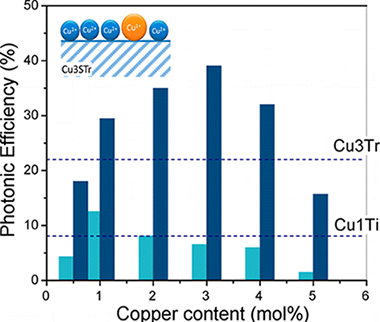
Abstract
A photocatalytic H2 evolution reaction was performed over copper doped TiO2. The influence of sulfate pretreatment over fresh TiO2 support and the Cu doping method has been evaluated. Wide structural and surface characterization of catalysts was carried out in order to establish a correlation between the effect of sulfuric acid treatment and the further Cu-TiO2photocatalytic properties. Notably a different copper dispersion and oxidation state is obtained by different metal decoration methods. From the structural and surface analysis of the catalysts we have stated that the occurrence of highly disperse and reducible Cu2+ species is directly related to the photocatalytic activity for the H2 production reaction. Highly active materials have been obtained from a chemical reduction method leading to 18 mmol·h–1·g–1for 3 mol % copper loading.
October, 2014 · DOI: 10.1021/cs500865y
Nanotecnología en Superficies y Plasma
Study of the early stages of growth of Co oxides on oxide substrates
Diaz-Fernandez, D; Mendez, J; Yubero, F; Dominguez-Canizares, G; Gutierrez, A; Soriano, LSurface and Interface Analysis, 46 (2014) 975-979 DOI: 10.1002/sia.5366
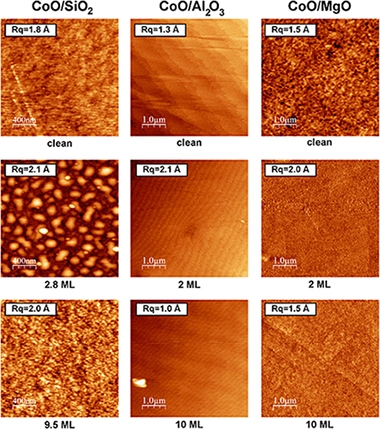
Abstract
The growth of Cobalt oxides by reactive thermal evaporation of metallic Cobalt in an oxygen atmosphere on a series of oxide substrates, namely SiO2, Al2O3 and MgO, has been chemically and morphologically studied by means of XPS and atomic force microscopy (AFM). The XPS results reveal that cobalt oxide grows as CoO (Co2+) for coverages up to some tens of equivalent monolayers on all substrates. For larger coverages, the formation of the spinel oxide Co3O4 has been observed. AFM and XPS quantification allowed us to determine the way of growth of CoO on all substrates, being of Volmer-Weber (i.e. islands) mode for SiO2, whereas for Al2O3 and MgO, the growth follows the Frank-van der Merwe (i.e. layer-by-layer) mode. The results are discussed in terms of the mismatch of the lattice parameters of the CoO adsorbates with the substrates
October, 2014 · DOI: 10.1002/sia.5366
Reactividad de Sólidos
Mechanochemically synthesized nanocrystalline Sb2S3 particles
Dutkova, E; Sayagues, MJ; Real, C; Zorkovska, A; Balaz, P; Satka, A; Kovac, J; Ficeriova, JActa Physica Polonica A, 126 (2014) 943-946 DOI: 10.12693/APhysPolA.126.943
Abstract
Nanocrystalline Sb2S3 particles have been synthesized from Sb and S powders by high-energy milling in a planetary mill using argon protective atmosphere. X-ray diffraction, particle size analysis, scanning electron microscopy, energy dispersive X-ray spectroscopy, transmission electron microscopy, electron diffraction, high resolution transmission electron microscopy, UV-VIS, and differential scanning calorimetry methods for characterization of the prepared particles were applied. The powder X-ray diffraction pattern shows that Sb2S3 nanocrystals belong to the orthorhombic phase with calculated crystallite size of about 36 nm. The nanocrystalline Sb2S3 particles are constituted by randomly distributed crystalline nanodomains (20 nm) and then these particles are forming aggregates. The monomodal distribution of Sb2S3 particles with the average hydrodynamic parameter 210 nm was obtained. The quantification of energy dispersive X-ray spectroscopy analysis peaks give an atomic ratio of 2:3 for Sb:S. The optical band gap determined from the absorption spectrum is 4.9 eV, indicating a considerable blue shift relative to the bulk Sb2S3. Differential scanning calorimetry curves exhibit a broad exothermic peak between 200 and 300°C, suggesting recovery processes. This interpretation is supported by X-ray diffraction measurements that indicate a 23-fold increase of the crystallite size to about 827 nm as a consequence of application of high temperature process. The controlled mechanochemical synthesis of Sb2S3nanoparticles at ambient temperature and atmospheric pressure remains a great challenge.
October, 2014 · DOI: 10.12693/APhysPolA.126.943
- ‹ previous
- 24 of 37
- next ›




